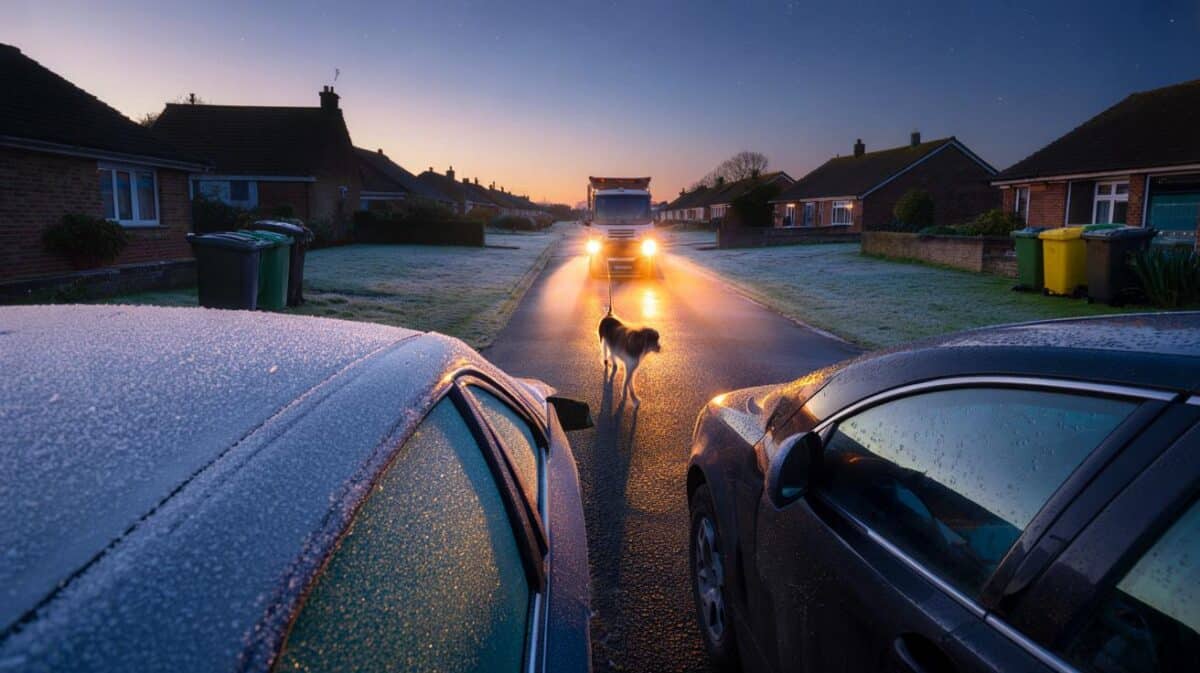Supporters see relief for jammed forecourts and frazzled drivers. Critics fear more traffic and a brighter night sky over the fields. The stakes feel bigger than a coffee and a splash-and-dash — jobs, safety, and how we travel are on the table.
The rain started halfway up the M-way and never really stopped. Windscreen on fast wipe, kids asking about snacks, the “No spaces” sign flashing at the next services like a dare. We squeezed in anyway, circling past idling HGVs and a queue of EVs looping like a string of fairy lights that forgot to twinkle. Trays balanced on knees, one eye on the clock, we did that gritty stop that isn’t a break so much as an interruption. Word is, a new mega services is coming — the sort with 550 parking spaces, proper zoning, and room to exhale. **It sounds like a fix for a familiar pain.** It promises relief — and raises questions.
A landmark services: big capacity, calmer stops
The outline is simple to grasp and ambitious in scale. A purpose-built motorway service area with up to 550 parking spaces, clearly separated for cars, HGVs, and coaches. Shops clustered around a weather-protected central street. An indoor-and-out play zone where kids can wobble off the road-wiggles. The scheme would lean on daylight, wide walkways, and sightlines you don’t need a map to read. Think solar canopies over bays, a dog-walk loop, and quiet corners for anyone who needs less noise. It’s a services designed to lower shoulders as much as it fills tanks and stomachs.
Set it against the reality many of us know. Weekend peaks turn some existing sites into rolling car-park sudoku, with cars and lorries crossing paths like impatient chess pieces. The developers say 550 spaces could soak up pressure on long runs and bank holiday surges, giving room for safer manoeuvres and shorter dwell times. Early documents point to dozens of rapid EV chargers from day one, with capacity to add more as uptake grows. Jobs would follow, from retail to maintenance, turning an empty plot into a round-the-clock, light-touch hub.
Why this much capacity? Traffic patterns tell a story: longer cars, more vans, and a chronic shortage of secure HGV bays where drivers can rest without fretting. EV adoption adds a fresh kind of queue, because charging takes time no matter how fast the cable. Designing for separation — cars here, HGVs there, coaches somewhere else entirely — reduces conflict and keeps movements legible. It’s not about sprawl for its own sake. It’s about eliminating the stressful overlap between different journeys unfolding in the same cramped space.
Make the most of a mega services
Get tactical the moment you see the signage. Follow the lane markings that match your stop — quick dash, family pause, or EV stint — and aim for the outer ring of car bays, a few rows from the exit path. That placement trims minutes on the way out and reduces the post-sandwich shuffle. If there’s an app or on-site screen showing live charger status, scan it before you park. Pick a charger with two empty bays to its left if you can — cable reach matters more than you think.
We’ve all had that moment when the whole car wants different things at once. Split the stop into one task each. Toilets, then hydration, then a five-minute stretch — no shopping detour until the basics are done. Keep kids’ play to a single zone you can see from a bench, and choose a bite that won’t knock everyone sideways. Let’s be honest: nobody does that every day. But on a long run, small structure stops the stop from running you.
Planners and drivers say the same thing in different words: space is safety.
“Big parking isn’t a luxury — it’s the margin you need when you’re tired, it’s the lane you didn’t cross, it’s the angle that lets you leave without a dent,” says a veteran HGV driver who logs 100,000 miles a year.
**The right features turn a stop from chaos to calm.**
- Look for clear separation between cars, HGVs, and coaches.
- Scan for rapid chargers with visible queues and overhead canopies.
- Choose play areas within sightlines of seating and loos.
- Use marked pedestrian routes back to your bay — they exist for a reason.
- Find the dog-walk loop if you’ve got a four-legged traveller.
- Check for 24/7 patrols and lighting in the zones you’ll use after dark.
The bigger picture: greener kit, local jobs, tricky trade-offs
Big roadside projects don’t arrive quietly. A 550-bay services comes with questions about farmland, light spill, junction tweaks, and how to stop rat-running on nearby lanes. The proposal leans hard on green kit to answer some of that: solar canopies, heat pumps, rainwater harvesting, and biodiversity net gain through new hedgerows, ponds, and habitat edges. Retail might prioritise regional producers, turning a pit stop into a small shop window for local food. **Done right, the place becomes a valve for a busy corridor, not a sponge that soaks up the countryside around it.** The test will be the details that never make the headline: acoustic bunds, dark-sky lighting, safer slip roads, and a layout that respects the silence beyond the boundary fence.
This plan doesn’t land in a vacuum. It slots into a network where tiredness is too common and EV charge anxiety is real. The promise is practical: more bays, shorter queues, safer turns. The risk is also practical: more trips triggered by a shiny new stop, and local roads feeling the rumble. Communities will weigh what’s gained against what’s changed, and drivers will vote with their brakes and wallets. If the service station becomes a place you actually want to pause — not just somewhere to endure — it might shift the culture of the road in small but meaningful ways. That’s the quiet revolution to watch.
| Point clé | Détail | Intérêt pour le lecteur |
|---|---|---|
| Capacity and layout | Up to 550 parking spaces with clear zones for cars, HGVs, coaches, and EVs | Lower stress, safer manoeuvres, quicker in-and-out |
| EV-first setup | Dozens of rapid chargers from launch, scalable with demand | Shorter queues today, future-proofed for tomorrow |
| Design with intent | Shops clustered around a weather-safe street, play areas, dog-walk loop, quiet corners | A stop that feels human, not just functional |
FAQ :
- Where exactly will the services be built?Developers are targeting a busy trunk corridor in England, with the precise plot subject to planning and public consultation. Expect confirmation as the application moves through committee.
- When could it open?If consent is granted on a standard timeline, construction could take 18–24 months, putting the earliest opening in late 2027 or 2028.
- How many EV chargers are planned?Early designs point to several dozen rapid points on day one with room to expand, plus a handful of ultra-rapid bays for high-demand peaks.
- Will it make local traffic worse?The scheme includes new slip-lane geometry, signal upgrades, and on-site queuing that keeps vehicles off the carriageway. Modelling suggests smoother flow at peak times on the mainline.
- What about the countryside and night sky?Mitigation measures include earth bunds, native planting, directional LED lighting, and “dark corridor” edges to protect wildlife, all aiming for biodiversity net gain.







